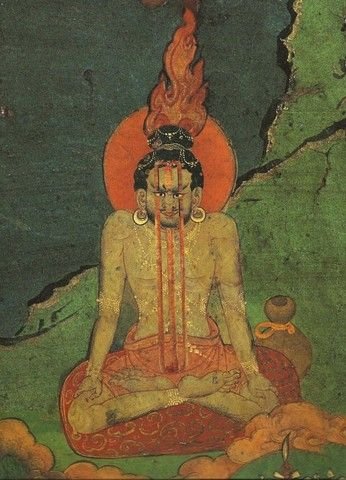TUMMO Tibetan
Gtum-mo ; Sanskrit: caṇḍālī. Literally means the fierce goddess of heat and passion in Tibetan Buddhist tradition.
Tummo is found in the Mahasiddha Krishnacarya and the Hevajra Tantra texts. Tummo (Tumo or Chandali yoga) also refers to a part of tantric meditation cycles and breathing exercises for yogic heat, that developed around the concept of fierce female deity.
It is found in the Six Yogas of Naropa, Lamdre , Kalachakra and Anuyoga teachings of Tibetan Vajrayana. The purpose of tummo is to gain control over body processes during the completion stage of ‘highest yoga tantra’ (Anuttarayoga Tantra ) or Anuyoga.
The “center channel” (dbu ma or avadhuti) is the whole arterial system, or more specifically the aorta. The two “side channels” are the venous system (roma or rasanā) and the spinal column and nervous system (rkyang ma or lalanā).
A chakra is any place in the body where there are clusters of arteries, veins and nerves. In the practice of tummo, the visualization of lower ends to the three channels is primarily used to focus body awareness in the subnavel area.
Breath retention, mulabandha and uddiyana bandha force vāyu (wind, air) and ojas into the arterial system. Ojas itself has two stores within the body—the heart and brain.
Thus there is the visualization of blazing and dripping. Kuṇḍalinī-yoga offered a range of techniques to harness the powerful psycho-physical energy coursing through the body.
Most people simply allow the energy to churn in a cauldron of chaotic thoughts and emotions or dissipate the energy in a superficial pursuit of pleasure, but a yogi or yogini consciously accumulates and then directs it for specified purposes.
This energy generates warmth as it accumulates and becomes an inner fire or inner heat (candālī) that [potentially] burns away the dross of ignorance and ego-clinging. Numerous non-buddhist tantras of the Shakta and Shaiva traditions (generally termed Hindu by westerners) speak of Kundalini, which is generally described as a coiled energy at the base of the spine, at the first chakra.

Kundalini yoga, Vajrayana, Nath Sampradaya, Mahasiddha and Milarepa: Kundalini yoga in the Natha Sampradaya and Vajrayana in Tibetan Buddhism both take their origin from the Mahasiddhas who were active in India from the 8th century to the 12th century.
Kundalini yoga practices formed the core of the teachings of a number of these Mahasiddhas and are strongly represented in both Tibetan Buddhist practices and contemporary kundalini yoga practices. Kundalini yoga was spoken of as “Candali yoga” by these Mahasiddhas and became known as gTummo rnal ‘byor in Tibet.
Candali yoga was a key practice of the famous Tibetan yogin Milarepa.
“The rLung practitioner (yogi) uses special colors of clothes to improve the power of the Tummo fire.” Dr Arya (2006)
The psychic heat Drod is produced by the space particles and the heat manifested from the friction of the wind element. This is another fundamental element as it supports and gives power to the consciousness, like the power of the fire that can launch rockets to space.

The power is called medrod or ‘digestion fire’ in medicine and Tummo in yoga tantra. The heat (fire) sustains life and protects the body/mind. The psychic fire increases the wisdom, burns the ignorant mind of the brain and gives realization and liberation from the darkness of unawareness.
That is why yoga describes Tummo as the aggressive fire which ignites from below navel, pierces the chakras one by one and reaches the sky of the crown chakra. The tummo burning arrow married with the celestial bride leads to enjoy the life of transformation of samsara. They give birth to the son of awareness from the blissful garden of Vajrayogini.

